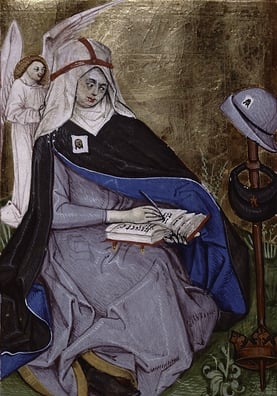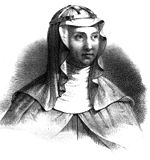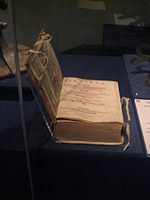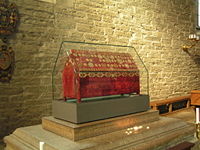Difference between revisions of "Bridget of Sweden" - New World Encyclopedia
m |
m (→References) |
||
| Line 142: | Line 142: | ||
==References== | ==References== | ||
| − | * Bridget, of Sweden saint. ''The Secret of Happiness: The Fifteen Prayers Revealed By Our Lord to Saint Bridget in the Church of Saint Paul in Rome''(New York : St. Francis of Assisi Church, [19—]. {{OCLC|25228073}} | + | * Bridget, of Sweden, saint. ''The Secret of Happiness: The Fifteen Prayers Revealed By Our Lord to Saint Bridget in the Church of Saint Paul in Rome''(New York : St. Francis of Assisi Church, [19—]. {{OCLC|25228073}} |
* Duffy, Eamon. ''The Stripping of the Altars: Traditional Religion in England 1400-1580'', New Haven and London: Yale University Press, 1994. ISBN 9780300060768 | * Duffy, Eamon. ''The Stripping of the Altars: Traditional Religion in England 1400-1580'', New Haven and London: Yale University Press, 1994. ISBN 9780300060768 | ||
* Gregersson, Birger, Thomas Gascoigne, and Julia Bolton Holloway. ''The Life of Saint Birgitta'', Toronto: Peregrina Pub. Co., 1991. ISBN 9780920669174 | * Gregersson, Birger, Thomas Gascoigne, and Julia Bolton Holloway. ''The Life of Saint Birgitta'', Toronto: Peregrina Pub. Co., 1991. ISBN 9780920669174 | ||
Revision as of 21:40, 15 January 2009
- This article is about Saint Bridget of Sweden. For Saint Brigid of Ireland, see Brigid of Kildare.
| Saint Bridget (Bridgid) of Sweden | |
|---|---|
altarpiece in Salem church, Södermanland, Sweden | |
| Widow | |
| Born | 1303 in Uppland, Sweden |
| Died | July 23, 1373 in Rome, Papal States |
| Venerated in | Roman Catholic Church Lutheran Church |
| Canonized | October 7, 1391
by Pope Boniface IX |
| Major shrine | Vadstena |
| Feast | July 23 / October 8 (Traditional Roman Catholics) |
| Attributes | book, staff |
| Patronage | Europe, Sweden, Widows |
Birgitta Birgersdotter (1303 – July 23, 1373), later known as Saint Birgitta, also known as Santa Brigida or St. Bridgid of Sweden and Birgitta of Vadstena (in Swedish commonly as den heliga Birgitta), was a Mystic and saint, and founder of the Bridgettine Order. She was married for over 20 years and had eight children.
From a young age she received revelations and her record of these is called, Celestial revelations which were translated into Latin and became quite popular in the Middle Ages. Also, through prayer, she was led to the Fifteen Oes prayers thought to have been received from Christ in revelation, these also spread throughout Europe and were featured often in the Book of Hours and other liturgical texts.
She lived in the time of the Hundred Years War and in August, 1370, Pope Urban V confirmed the Rule of her congregation. At which time Bridget urged the removal of the Holy See from Avignon back to Rome.
Uniquely among saints of the second millennium, she was also the mother of a saint—Saint Catherine of Vadstena of Sweden. She was a contemporary of Julian of Norwich and Catherine of Siena, all of whom wrote a book on Revelations. She and her daughter, and Catherine worked together to defend the papacy and elevate the moral tone of the age.
She traveled on pilgrimage to Santiago de Compostela (with her husband) and Jerusalem (after his death) and spent the latter part of her life in Rome where she died at 70.
Life
The most celebrated saint of Sweden was the daughter of Birger Persson of the family of Finsta, governor and lawspeaker of Uppland, and one of the richest landowners of the country, and his wife, a member of the so-called Lawspeaker branch of the Folkunga family. Through her mother, young Birgitta was a relation of the Swedish kings of her lifetime. Her family was said to have been devout. Saint Ingrid, whose death had occurred about twenty years before Bridget's birth, was a near relative of the family. Bridget's father, grandfather, great-grandfather and great-great-grandfather each had gone on pilgrimage to Jerusalem to walk in the path of James, the brother of Jesus. She received a careful religious training, and from her seventh year showed signs of extraordinary religious impressions. Her mother died when Bridget was young and she was raised by her maternal aunt. She began having visions after her mother died (c. 1315). Her aunt advised her to keep her visions quiet for fear of being misunderstood.
In 1316 at 18, she was married to Ulf Gudmarson of the family of Ulvåsa, prince of Närke, to whom she bore eight children, one of whom was afterward honored as St. Catherine of Sweden. Birgitta’s saintly and charitable life soon made her known far and wide; she gained, too, great religious influence over her husband, with whom (1341–1343) she went on pilgrimage to Santiago de Compostela, after their return they decided to live in a monastery and got rid of all their worldly possessions.
In 1344, shortly after their return, Ulf died in the Cistercian monastery of Alvastra in Östergötland, and Birgitta, at 41, now devoted herself wholly to religion.
It was about this time that she founded the Order of St. Saviour, or the Bridgettines, of which the principal house at Vadstena, was richly endowed by King Magnus Eriksson of Sweden and his queen. In Sweden she created a poor house and when possible went to serve them herself. "She washed their feet and clothed them and visited them when they were infirm and handled their wounds and bodies with tender compassion and the greatest of maternal charity." (The Life of Saint Birgitta by Prior Peter and Master Peter)
Visions
As a child, she had already believed herself to have had visions; as she grew older they became more frequent. In 1345, a year after her husband's death, the first divine revelations came to Birgitta while she was awake and in prayer that she began to record called "Revelationes coelestes" ("Celestial revelations") which were translated into Latin by Matthias, canon of Linköping, and by her confessor, Peter, prior of Alvastra. They obtained a great popularity during the Middle Ages. Her visions of the Nativity of Jesus had a great influence on depictions of the Nativity of Jesus in art. Shortly before her death, she described a vision which included the infant Jesus as lying on the ground, and emitting light himself, and describes the Virgin as blond-haired; many depictions followed this and reduced other light sources in scenes to emphasize this effect, and the Nativity in art was commonly treated with chiaroscuro through to the Baroque period. Other details often seen such as a single candle "attached to the wall," and the presence of God the Father above, also come from Bridget's vision:
...the virgin knelt down with great veneration in an attitude of prayer, and her back was turned to the manger.... And while she was standing thus in prayer, I saw the child in her womb move and suddenly in a moment she gave birth to her son, from whom radiated such an ineffable light and splendor, that the sun was not comparable to it, nor did the candle that St. Joseph had put there, give any light at all, the divine light totally annihilating the material light of the candle.... I saw the glorious infant lying on the ground naked and shining. His body was pure from any kind of soil and impurity. Then I heard also the singing of the angels, which was of miraculous sweetness and great beauty...
After which the Virgin kneels to pray to her child, to be joined by Joseph, and this (technically known as the Adoration of the Child) becomes one of the most common depictions in the fifteenth century, largely replacing the reclining Virgin in the West. Versions of this depiction were seen as early as 1300, well before Bridget's vision, and have a Franciscan origin, she may have been influenced by them.[1]
Her visions of purgatory and of the passion of Christ were also well known.[2]
The Fifteen 'Our Father and Hail Mary prayers'
Saint Bridget prayed for a long time to know how many blows Jesus Christ suffered during His terrible passion. Rewarding her patience, one day He appeared to her and said: "I received 5475 blows upon My Body. If you wish to honor them in some way, recite fifteen Our Fathers and fifteen Hail Marys with the following Prayers, which I Myself shall teach you, for an entire year. When the year is finished, you will have honored each of My Wounds."
The prayers became known as the Fifteen Oes, because in the original Latin, each prayer began with the words O Jesu, O Rex, or O Domine Jesu Christe (O Jesus; O King; O Lord Jesus Christ). Some have questioned whether Saint Bridget is in fact their author; Eamon Duffy reports that the prayers probably originated in England, in the devotional circles that surrounded Richard Rolle or the English Brigittines.[3]
Whatever their origin, the prayers were quite widely circulated in the late Middle Ages, and became regular features in Books of Hours and other devotional literature. They were translated into various languages; an early English language version of them was printed in a primer by William Caxton. The prayers themselves reflect the late medieval tradition of meditation on the passion of Christ, and are structured around the seven last words of Christ. They borrow from patristic and Scriptural sources as well as the tradition of devotion to the wounds of Christ.
During the Middle Ages, the prayers began to circulate with various promises of indulgence and other assurances of supernatural graces supposed to attend from their regular recitation over the course of a year. These indulgences were repeated in the manuscript tradition of the several Book of Hours, and may constitute one major source of the prayers' popularity in the late Middle Ages. They promise, among other things, the release from Purgatory of fifteen of the devotee's family members, and that they would keep fifteen living family members in a state of grace.
The extravagance of the promises made in these rubrics — one widely circulated version promised that the devotee would receive "his heart's desire, if it be for the salvation of his soul"[4] — attracted critics early and late. In 1538, William Marshall enjoined his readers to "henseforth ... forget suche prayers as seynt Brigittes & other lyke, whyche greate promyses and perdons haue falsly auaunced."[5] In 1954, the Acta Apostolicae Sedis found the alleged promises (though not the prayers themselves) unreliable, and directed local ordinaries not to permit the circulation of pamphlets containing the promises.[6]
Saint Bridget prayed for a long time to know how many blows Jesus Christ suffered during His terrible passion. Rewarding her patience, one day Jesus appeared to her and said: "I received 5475 blows upon my body. If you wish to honor them in some way, recite fifteen Our Fathers and fifteen Hail Marys with the following Prayers, which I Myself shall teach you, for an entire year. When the year is finished, you will have honored each of My Wounds." Christ granted these promises to all who devoutly recite the 15 Saint Bridget Prayers every day for a year:
1. I will deliver 15 souls of his lineage from Purgatory.
2. 15 souls of his lineage will be confirmed and preserved in grace.
3. 15 sinners of his lineage will be converted.
4. Whoever recites these Prayers will attain the first degree of perfection.
5. 15 days before his death I will give him My Precious Body in order that he may escape eternal starvation; I will give him My Precious Blood to drink lest he thirst eternally.
6. 15 days before his death he will feel a deep contrition for all his sins and will have a perfect knowledge of them.
7. I will place before him the sign of My Victorious Cross for his help and defense against the attacks of his enemies.
8. Before his death I shall come with My Dearest Beloved Mother.
9. I shall graciously receive his soul, and will lead it into eternal joys.
10. And having led it there I shall give him a special draught from the fountain of My Deity, something I will not for those who have not recited My Prayers.
11. Let it be known that whoever may have been living in a state of mortal sin for 30 years, but who will recite devoutly, or have the intention to recite these Prayers, the Lord will forgive him all his sins.
12. I shall protect him from strong temptations.
13. I shall preserve and guard his 5 senses.
14. I shall preserve him from a sudden death.
15. His soul will be delivered from eternal death.
16. He will obtain all he asks for from God and the Blessed Virgin.
17. If he has lived all his life doing his own will and he is to die the next day, his life will be prolonged.
18. Every time one recites these Prayers he gains 100 days indulgence.
19. He is assured of being joined to the supreme Choir of Angels.
20. Whoever teaches these Prayers to another, will have continuous joy and merit which will endure eternally.
21. There where these Prayers are being said or will be said in the future God is present with His grace.[7]
Presence in Rome
About 1350, she went to Rome, partly to obtain from the pope the authorization of the new order, and partly in pursuance of her self-imposed mission to elevate the moral tone of the age. It was not until 1370 that Pope Urban V confirmed the rule of her order, but meanwhile Birgitta had made herself beloved in Rome by her kindness and good works. Bridget made an earnest request to Pope Urban to return the Holy See back to Rome from Avignon. She and her daughter, Catherine of Vadstena, worked with Catherine of Siena to defend the papacy during this time.
Save for occasional pilgrimages, including one to Jerusalem in 1373, she remained in Rome until her death on July 23, 1373, aged 70. She was originally buried at San Lorenzo in Panisperna before being moved to Sweden. She was canonized in the year 1391 by Pope Boniface IX, and confirmed by the Council of Constance in 1415. Her final resting place is at the Vadstena Abbey, the site where the Bridgettine Order was first established.
Legacy
Bridget of Sweden, was a devout Christian woman who inspired her own nation and its rulers to live a more religious and moral lifestyle. Through her revelatory writings and prayers she influenced Europe. Her church and convent at Vadstena became a place welcoming other religious women including her own daughter, Catherine (Saint Catherine of Vadstena). Her mystical visions inspired others to devotion to Christ and miracles were reported through veneration of this saint. In her travels to other nations and cities she would encourage others toward the religious and pious life, even scolding those rulers who she found wanting. She defended the papacy and encouraged Pope Urban I to return the Holy See to Rome from Avignon, Rome being the rightful seat of [[Saint Peter].
She living during the time of the Hundred Years War in Europe and was a contemporary of Catherine of Siena, and Julian of Norwich. All three women, including Bridget, wrote books called Revelations, Bridget's beginning around 1345 until her death in 1373, Catherine's, from 1377-1378, and Julian's perhaps from 1368-1413. Margery Kempe copied these texts and aided their distribution. These women are linked by the Norwich Benedictine, Cardinal Adam Easton who wrote the Defensorium Sanctae Birgitta in Norwich, 1389-1391, defending the women's visionary writings.
Her shrine is at Vadstena convent, the main site of the Brigettine Order that she founded in Sweden.
In 1651, the Brigitta Chapel was erected in Vienna, and in 1900 the new district Brigittenau was founded.
In 1999, Pope John Paul II named Bridget as a patron saint of Europe. Her feast is celebrated on July 23, the day of her death. Bridget's feast was not in the Tridentine Calendar, but was later inserted in the Roman Catholic Calendar of Saints in 1623 for celebration on October 7, the day she was canonized by Pope Boniface IX in the year 1391. Five years later, her feast was moved to October 8, where it remained until the revision of the Roman Catholic Calendar of Saints in 1969. Traditional Roman Catholics continue to celebrate the feast day of "Saint Bridget, Widow" on October 8.
See also
- Patron saint
- List of Christian mystics
- Julian of Norwich
- Catherine of Siena
- Margery Kempe
- Catherine of Vadstena
Notes
- ↑ Schiller, 1971, pp. 76-78.
- ↑ Eamon Duffy, The Stripping of the Altars: Traditional Religion in England 1400-1580, Yale University Press, 1992, p 338.
- ↑ Duffy, The Stripping of the Altars, p. 249.
- ↑ Ibid.
- ↑ Summit, Jennifer. Lost Property: The Woman Writer and English Literary History, 1380-1589, Univ. Chicago, 2000. ISBN 9780226780139
- ↑ Acta Apostolicae Sedis, "Since in this book it is claimed that several promises were made by God to St. Bridget, and the supernatural origin of those promises has been in no way established, the local Ordinaries are admonished not to authorize the publication or distribution of pamphlets or writings containing those promises." XLVI (1954), 64.
- ↑ saintbirgitta.com Complete Revelations, free download Retrieved January 7, 2009.
ReferencesISBN links support NWE through referral fees
- Bridget, of Sweden, saint. The Secret of Happiness: The Fifteen Prayers Revealed By Our Lord to Saint Bridget in the Church of Saint Paul in Rome(New York : St. Francis of Assisi Church, [19—]. OCLC 25228073
- Duffy, Eamon. The Stripping of the Altars: Traditional Religion in England 1400-1580, New Haven and London: Yale University Press, 1994. ISBN 9780300060768
- Gregersson, Birger, Thomas Gascoigne, and Julia Bolton Holloway. The Life of Saint Birgitta, Toronto: Peregrina Pub. Co., 1991. ISBN 9780920669174
- Mulder-Bakker, Anneke B. Sanctity and motherhood: essays on holy mothers in the Middle Ages, New York: Garland Pub., 1995. ISBN 9780815314257
- Schiller, Gertrud. Iconography of Christian Art, Vol. I, (English trans from German), Greenwich, Conn., New York Graphic Society [1971-72]. OCLC 213792773
- Summit, Jennifer. Lost Property: The Woman Writer and English Literary History, 1380-1589, Univ. Chicago, 2000. ISBN 9780226780139
External links
All links retrieved January 7, 2009.
- saintbirgitta.com Complete Revelations, free download
- article Saint Birgitta of Sweden from Catholic encyclopedia.
- Website on Saint Birgitta of Sweden, giving her Latin Revelationes
- The Revelations of St. Birgitta of Sweden
Credits
New World Encyclopedia writers and editors rewrote and completed the Wikipedia article in accordance with New World Encyclopedia standards. This article abides by terms of the Creative Commons CC-by-sa 3.0 License (CC-by-sa), which may be used and disseminated with proper attribution. Credit is due under the terms of this license that can reference both the New World Encyclopedia contributors and the selfless volunteer contributors of the Wikimedia Foundation. To cite this article click here for a list of acceptable citing formats.The history of earlier contributions by wikipedians is accessible to researchers here:
The history of this article since it was imported to New World Encyclopedia:
Note: Some restrictions may apply to use of individual images which are separately licensed.




